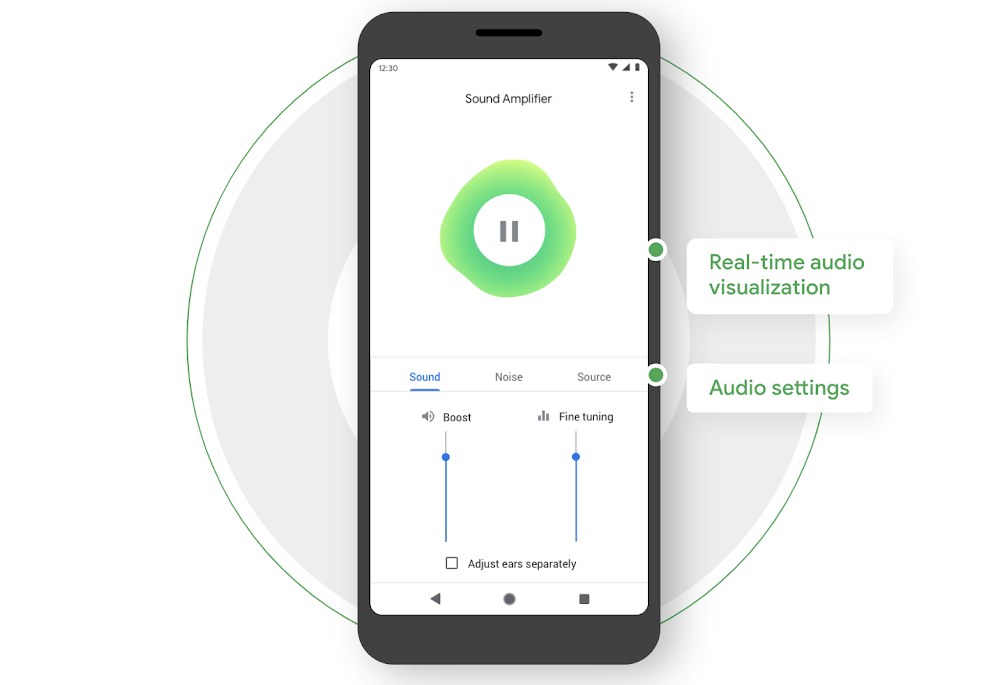In seeking to see if there was an app in the Google Play Store equivalent to Andrew Sabin’s EarMachine app, which was the precursor of the Bose HearPhone technology (and can be downloaded for free from the Apple App Store), I couldn’t find the Android equivalent but noticed that the Google app Sound Amplifier is actually very similar to the EarMachine app, at least in terms of offering the user a very simple interface for controlling sound quality and noise suppression and turning your phone into a remote microphone for wired or, now, BT headphones (or HA’s, in certain circumstances).
The main problem with BT is there’s a lot of latency. But I could use Sound Amplifier to turn my phone into a remote microphone for my MS Surface BT wireless noise-cancelling headphones or my ReSound Quattro’s using the Phone Clip+ streamer as my “classic” BT connection to my phone.
I found that if I turned on my Multi Mic that I could now effectively have two remote microphones (but both not operational at the same time) connected to my Quattro’s and easily and quickly switch back and forth. The Multi Mic, since it is connected directly to my HA’s through ReSound’s proprietary BLE protocol, is NOT controlled by the Sound Amplifier. If Sound Amplifier is turned off via its PLAY |> button, the Multi Mic will be the input my HA’s prefer, even if the PC+ streamer is turned on. If I turn on Sound Amplifier by hitting its PLAY button, then my HA’s switch to receiving sound input from my phone microphone. And I can go back and forth this way as much as I want. I presume that if I wanted, I could use my TV Streamer 2 in addition or in place of the Multi Mic in the interaction with or without my phone microphone using Google’s Sound Amplifier. Sound Amplifier only controls the phone microphone sound parameters. The sophisticated sound and noise controls in the ReSound Smart 3D app control the sound parameters of the Multi Mic or the TV Streamer 2 when in use. IMHO, the sound quality from my Multi Mic is far superior to that from my Galaxy Note 8 phone microphone.
The utility of having two remote microphones via the Google Sound Amplifier app being turned on or off on my phone is obviously limited by having to have access to my phone to perform the switch. So the basic noisy restaurant scenario where I could see this being useful is to give my phone to someone sitting next to me on a round table or across from me on the end of a long table and give the Multi Mic to someone across a big round table or down at the other end of a long table. Then my phone would be nearby to me to use to switch between hearing a conversation near me with one “remote” microphone (the one on my phone via Sound Amplifier) versus the conversation farther away from me (the one on the Multi Mic, controlled by the ReSound Smart 3D app).
Relative to any similarities between Google’s Sound Amplifier app and the Andrew Sabin EarMachine app, which became the basis for Bose’s HearPhone app, as documented in David Owen’s book Volume Control (https://forum.hearingtracker.com/t/hearing-loss-in-history/54070?u=jim_lewis and https://forum.hearingtracker.com/t/book-recommendation-volume-control/48598?u=jim_lewis), I can see that Sound Amplifier’s Boost control corresponds to the EarMachine’s World Volume control but I’m at a loss as to exactly what the Fine Tuning control in Sound Amplifier does*** versus the Fine Tuning control for the EarMachine, which seems to control the relative balance of bass and treble, providing a primitive equalizer function not as sophisticated as that in hearing aids where individual frequency ranges can be specifically adjusted. From the way the “surround” circle deforms in the Google Sound Amplifier app, one might (erroneously?) presume that it is performing a carotid (directionality) function???
BTW, the Help instructions for Google Assistant indicate Sound Amplifier will work directly with hearing aids and phones supporting the ASHA BT protocol. I would be very interested to know from anyone who’s tried this whether the ASHA protocol greatly reduces the latency effect with classic BT when used with Google Sound Amplifier.
*** Edit_Update: See next post. The “Fine Tuning” slider for the Google Sound Amplifier app appears to be a Bass/Treble slider, same as the Fine Tuner for the EarMachine. So even though Google claims to have invented Sound Amplifier from scratch, it appears to be a copy of most EarMachine functionality (I guess neither is very original). Don’t have an iPhone, can’t try EarMachine but the Noise Control tab in Sound Amplifier works pretty well to filter out droning white noise - don’t know if the EarMachine app has similar.

